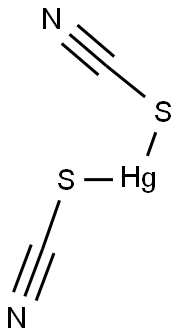티오시안산, 수은 C화학적 특성, 용도, 생산
화학적 성질
Mercuric thiocyanate is an inorganic chemical substance. It is a stable solid at room temperature, and depending upon the purity, it appears as odourless white crystalline powder or grey. It is insoluble in water and denser than water and sinks in water. On decomposition, mercuric thiocyanate releases hazardous substances such as cyanide vapours, vapours of mercury, oxides of nitrogen (NO, NO2), and oxides of sulphur (SO2, SO3). Mercury thiocyanate has limited uses in chemical synthesis.
용도
For Pharaoh's serpents (fireworks); intensifier in photography.
공기와 물의 반응
Insoluble in water.
반응 프로필
MERCURIC THIOCYANATE decomposes into its elements at about 165°C. Burns readily in air to generate a coil of cohesive ash resembling a serpent (hence used in a firework: Pharaoh's serpents). Swells up to many times its original volume if heated [USCG, 1999]. Soluble in dilute hydrochloric acid [Merck]. Incompatible with strong oxidizing agents.
위험도
Highly toxic by ingestion, inhalation, and
skin absorption.
건강위험
Mercuric thiocyanate causes severe eye and skin irritation with possible burns and causes digestive and respiratory tract irritation with possible burns. It may impair fertility, may cause harm to the unborn child, is harmful if inhaled, may cause allergic skin reaction, may cause kidney damage, may cause CNS effects, is light sensitive, and is a severe marine pollutant. Contact with acids liberates very toxic gas. The target organs include kidneys, CNS, reproductive system, eyes, and skin.
Safety Profile
A poison by ingestion
and intraperitoneal routes. Moderately toxic
by skin contact. Thermally unstable and
decomposition may be vigorous. When
heated to decomposition it emits very toxic
fumes of Hg, NOx, SOx, and CN-. See also
MERCURY COMPOUNDS and
CYANATES.
잠재적 노출
Mercury thiocyanate is used in
photography and fireworks.
운송 방법
UN1646 Mercury thiocyanate, Hazard Class:
6.1; Labels: 6.1-Poisonous materials.
Purification Methods
Recrystallise it from H2O, and it can give various crystal forms depending on conditions. Its solubility in H2O is 0.069% at 25o, but is more soluble at higher temperatures. It decomposes to Hg above 165o. Poisonous. [Mason & Forgeng J Phys Chem 35 1121 1931, Birckenbach & Kolb Chem Ber 68 919 1935.]
비 호환성
Incompatible with oxidizers (chlorates,
nitrates, peroxides, permanganates, perchlorates, chlorine,
bromine, fluorine, etc.); contact may cause fires or explosions. Keep away from alkaline materials, strong bases,
strong acids, oxoacids, epoxides. Mercury thiocyanate is
sensitive to heat; expands to many times its original volume
and then decomposes at freezing/melting point forming
toxic fumes of sulfur oxides, mercury cyanide, and nitrogen
oxides. Contact with acid or acid fumes causes release
of toxic mercury and cyanide vapors. Incompatible with
chlorine, reducing agents such as hydrides, sulfides
폐기물 처리
Small amounts may be
destroyed by alkaline hydrolysis. Admixture with alkali
can be followed by soil burial. Larger quantities can be
disposed of by incineration in admixture with acetone or
xylene and using effluent gas scrubbing. Do not reuse
empty container; proper disposal required.
티오시안산, 수은 준비 용품 및 원자재
원자재
준비 용품









